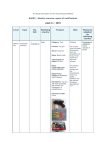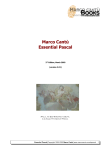Download Nuptse tutorial
Transcript
Nuptse tutorial
Matthieu ANNE
November 23, 2007
Abstract
1
Introduction
By following this tutorial, you will go through the basic concepts that you will
inevitably need while developing your own Nuptse application. All these concepts are illustrated with concrete examples which can be found on ObjectWeb
svn1 .
This document contains:
• basic example;
• presenting the use of fractal controllers
• Attribute controller
• LCC
• Binding controller
• component identity
• Abstract component
• composite component
• content controller
1.1
Configuration
To build the examples, you need to install the Nuptse environment and get
a copy of the Kortex component library. The latest ant version2 (at least the
1.7.0), Java 5 and a C compiler are also required. You can get a copy of Nuptse
and Kortex from the ObjectWeb svn3 . $THINK PATH and $KORTEX PATH must
1 To get a copy of examples used in this tutorial:
# svn checkout svn://svn.forge.objectweb.org/svnroot/think/experiments/mattBasis/nuptseBasis
2 http://ant.apache.org/
3 To get the Nuptse and Kortex trunk:
# svn checkout svn://svn.forge.objectweb.org/svnroot/think/trunk
# svn checkout svn://svn.forge.objectweb.org/svnroot/think/kortex/trunk/src
1
be defined according to the place you ”checkout-ed” each project. Finally, you
need to build a Nuptse distribution4 .
Once you have done or checked all these configuration aspects, you are ready
to build and run each example described below. To do so, get into one of the
examples directory, build the example using the default ant target (# ant), and
then look in the build/obj unix to run the example.
2
Basic example
(00helloWorld)
The helloWorld example described here is the simplest example which serves
as an example of reference. All the following examples are based on the same
structure (cf. Figure 1) with different variations: a component called wtsh
(”Wish To Say Hello”) wants to say ”Hello World” in several languages, others
know how to do this. Therefore, components need to be bound to one another
to accomplish this fundamental mission. You might find the description of this
example a bit long, and getting into too much detail, but this is needed to make
it possible to get straight into the interesting points in the next examples.
Figure 1: Architecture of 00helloWorld example.
The aim of this example is to point out the roles of the three types of files
you will usually find in a Nuptse application. Those files correspond to .adl, .idl
and .c files:
• .adl are used to specify components architecture, establishing the relationship between the components used to build the application;
• .idl gives a description of a required or provided interface, specifying the
methods which are accessible through, or defined in, the interface;
• .c is the implementation associate to a component notably invoking and
defining interface methods.
Three different programming languages are used for those files, which are respectively the Architecture Description Language, the Interface Description
Language and NuptC. Through the description of the following examples
some elements of those languages will be introduced. To have more information
about these programming languages, please refer to the Think User Manual (
TODO thinkUserMan Ref).
4 To build a Nuptse distribution:
# cd $THINK PATH/thinkadl
# build dist
2
2.1
Architecture description
The architecture is described using .adl files. One of this type of file is needed
for each component. Therefore, one adl file will give a general description of the
application architecture, and other adl files will give a description of components
needed by the application.
TODO this is approximative...
2.1.1
Main architecture description
The general architecture of this first example (corresponding to the diagram
shown in Figure 1) is described in the main.adl file (cf. Figure 2). This file
specifies that the main component is composed of three components, namely
boot, wtsh (wish to say hello) and multiLanguageHello components. Those
components are respectively described in boot.lib.boot, wishToSayHello and
multiLanguageHello adl ’s. The first one comes from the Kortex library and
will not be described here5 . The two other components will be described below.
1
component main {
contains boot = boot.lib.boot
contains wtsh = wishToSayHello
contains multiLanguageHello = multiLanguageHello
5
binds boot.entry to wtsh.main
binds wtsh.hello to multiLanguageHello.hello
}
Figure 2: main.adl : description of the 00helloWorld example architecture.
The main architecture description also contains two binding descriptions.
The client interface entry of the boot component is bound to the server interface main of the wtsh component, and the client interface hello of the wtsh
component is bound to the server interface hello of the multiLanguageHello
component. To be bound together, a client and a server interface must have the
same type, that is to say they must share the same interface description (.idl).
Client and server interface description of a given component is addressed in the
next two sections.
2.1.2
wishToSayHello description
The wishToSayHello component is what we call a primitive component; this
component doesn’t contain any sub-components. The description of this component is given in wishToSayHello.adl (cf. Figure 3). This description file
specifies that this component has one server interface called main and one client
interface called hello. Those interfaces are respectively of activity.api.Main
and api.multiLanguageHello type. As the activity.api.Main interface is
5 If the application you’ve build never ends, it might be because the boot component you
are using has a while(1) loop. This is because the Kortex library is meant to be use to build
os’s. You can still use your own boot component if you wish your application to end.
3
part of the Kortex library6 , it will not be discussed here. However, interface
description will be discussed in section 2.2 based on api.MultiLanguageHello
interface. Finally, content wishToSayHello specifies that the implementation
of the wishToSayHello component can be found in wishToSayHello.c.
1
5
component wishToSayHello {
provides activity.api.Main as main
requires api.MultiLanguageHello as hello
content wishToSayHello
}
Figure 3: wishToSayHello.adl : description.
2.1.3
multiLanguageHello description
As we can see in Figure 4, the multiLanguageHello component is even simpler. This component only has one server interface called hello. We can
notice that this provided interface corresponds to the interface required by
the wishToSayHello component (cf. Figure 3), both of them being of type
api.MultiLanguageHello. The implementation of this component can be found
in multiLanguageHello.c as specified by content multiLanguageHello.
1
component multiLanguageHello {
provides api.MultiLanguageHello as hello
content multiLanguageHello
}
Figure 4: multiLanguageHello.adl : description.
2.2
Interface description
In this first example, two different types of interface are used. The first one,
activity.api.Main, is defined in the Kortex library. The second one, api.MultiLanguageHello,
is describe in MultiLanguageHello.idl (cf. Figure 5) and can be found in the
src/api/ directory. This MultiLanguageHello interface is very simple, providing one method for each required languages. The purpose of those methods is
to print this universal greeting message, ”Hello World”, in different languages.
Nevertheless, a moreInfo argument has been added, for example to be able to
print out who wanted to say ”Hello World”, to increase the comprehension of
the background mechanism at runtime.
2.3
Component implementation
Once we have done all the description part, describing architectures, describing
interfaces; it is time for us to really get doing something. As there are three
6 cf.
$KORTEX PATH/generic/activity/api/ to get more details
4
1
package api;
5
public interface MultiLanguageHello {
void printEnglishHello(string moreInfo);
void printFrenchHello(string moreInfo);
void printGermanHello(string moreInfo);
}
Figure 5: MultiLanguageHello.idl : description of the MultiLanguageHello interface.
primitive components, at least three implementations need to be defined. For
the same reason as previously mention, the boot component implementation is
not detailed here. The multiLanguageHello isn’t detailed either for being too
simple, but you can still have a look the multiLanguageHello.c file. So let’s have
a look at the implementation of the wtsh component (Figure 6).
1
/**
* @@ DefaultClientMethods @@
* @@ DefaultServerMethods @@
*/
5
10
15
20
/**
* @@ PrivateData @@
*/
struct {
unsigned int repeatNb;
} privInfo;
/**
* @@ PrivateMethod @@
*/
void myPrivMeth(char *moreInfo) {
printEnglishHello(moreInfo);
printFrenchHello(moreInfo);
printGermanHello(moreInfo);
}
void main(jint argc, jstring* argv) {
int i;
privInfo.repeatNb = 2;
25
for (i = 0; i<privInfo.repeatNb; i++)
myPrivMeth("Using private method");
printEnglishHello("Direct call to client method");
printFrenchHello("Direct call to client method");
printGermanHello("Direct call to client method");
30
}
Figure 6: wishToSayHello.c: implementation.
After a quick look, any readers should notice some strange notations located
5
in commented regions of code. Actually, these are annotations that are used
for example to determine to which interface a specific method belongs, or to
rename a client method to disambiguate special situation. These annotations
are specific to NuptC (TODO Ref Think User Man) and there are more of
those annotations to come in the following examples. However, annotations are
defined in comment sections between @@ flags.
In the implementation of this example, a private data privInfo and a private method myPrivMethod are defined respectively using PrivateData and
PrivateMethod annotation. Thus, these data and method can only be used
locally. The three other annotations, that is to say DefaultServerMethods and
DefaultClientMethods, define that server methods, and clients methods use
default names. Default server or client methods names comes from the idl description. In this example, there aren’t any ambiguous situations between client
methods or server methods, so default names can be used. We will introduce
later some cases where default names can’t be used. Going further, if you need
to define more than one private data, it must be done in struct structure.
You can also notice that private methods can call methods defined in a client
interface.
3
Attribute controller
Attribute manipulation and multiple instance.
• declaration dans l’adl
• declaration (annotation) dans .c
• initialisation dans adl
• initialisation dans .c
• attribute controller (modification des attribut d’un composant a partir
d’un autre)
The description of this component also defines a component attribute called
repeatNbAtt to which a specific value is assigned. This attribute is only used
to repeat ”Hello World” as many times it is defined (in case you did not understand).
Annotation DefaultAttributes defines that attributes use default names.
Default attribute names comes from the adl description.
ambiguous situations between attributes names so default names can be used
4
Life cycle controller
Unlike other controllers, lcc bindings do not necessarily need to be explicitly
defined. These bindings are manage at compilation time, and the start and
stop methods it proposes are called only once respectively at the start and end
of the runtime.
6
5
Binding controller
Binding description is one of the foundamental concept of the Fractal model7 .
Indeed, to enable a component to use the functionalities offered by a second,
the two components need to be linked. As it has been previously described,
this can be done through the architecture description (using adl files), doing it
only this way defines statical bindings. However, some application might need
dynamic bindings, ie the bindings between components might be defined and
changed at runtime.
The following examples are based on the same structure shown in Figure 7.
Here the application is composed of two instances of the multiLanguageHello
component (ie hello1 and hello2 ) to which a name attribute is added. A wtsh
component requires two hello interfaces offered by multiLanguageHello components. The main architecture description defines the initial links (cf. Figure 8)
which will dynamically change at runtime, swapping one multiLanguageHello
component with the other one.
main
boot
hello1
wtsh
entry
hello1
main
hello
hello2
hello1
hello
Figure 7: Representation of the helloworld example ADL.
1
5
component main {
contains boot =
contains wtsh =
contains hello1
contains hello2
boot.lib.boot
wishToSayHello
= multiLanguageHello
= multiLanguageHello
assigns hello1.name = "hello 1"
assigns hello2.name = "hello 2"
10
binds boot.entry to wtsh.main
binds wtsh.hello1 to hello1.hello
binds wtsh.hello2 to hello2.hello
}
Figure 8: main.adl description.
They are mainly two ways for dealing with dynamic binding. The first way
is doing it locally, considering bindings methods, such as bind or unbind, as
private methods. The second way is to require a binding controller interface
and to bind to a component which provides this interface.
7 TODO
insert Fractal REF
7
5.1
Local binding management
02helloWorld
In this example we decided to manage the dynamic bingings of hello interfaces
required by the wtsh component (cf. Figure 9) directly inside the component
itself. To do so, we use a set of keywords provided by NuptC to help implementing Fractal controller interfaces. These keywords corresponds to macros
enabling to initialize implementation code at compile time considering the architecture, and to access or modify meta-data at runtime. All these keywords
are prefixed with META . To get more information on these keywords please refer
to the Think User’s Manual 8 .
1
component wishToSayHello {
provides activity.api.Main as main
requires api.MultiLanguageHello as hello1
requires api.MultiLanguageHello as hello2
5
content wishToSayHello
}
Figure 9: wishToSayHello.adl description.
Let’s have a look at the wishToSayHello implementation shown in Figure 10,
starting with the annotations9 . Here, the wishToSayHello component requires
two interfaces of the same type (ie api.MultiLanguageHello), this result in an
ambiguous situation. To determine which interface the implementation refers to,
the printLanguageHello methods are renamed as hello1 printLanguageHello
and hello2 printLanguageHello using the @@ ClientMethod(...) @@ annotation. Then the bind and lookup methods are defined as private methods using
the @@ PrivateMethod @@ annotation. These methods uses META CLT ITF SET
and META CLT ITF GET macros to repectively set the server interface identifier
to a given interface identifier, and get the server interface identifier of a given
client interface identifier. Finally, invocations to those methods are done in the
provide main function, implementing the functional code of the component wtsh.
Here the choice has been made to implements binding methods as private
methods. However, as the wtsh implements binding methods, we could have
decided that this component also provides a BindingController interface that
could be offered to other components. This can be done by specifying the provided interface (fractal.api.BindingController) in the wishToSayHello.adl
description, adding the unbind method in the implementation of this component, and deleting the @@ PrivateMethod @@ annotations10 . Doing it this
way, bindings method can either be use locally or invoked by other components. If those methods are called locally, they will be assimilated to private methods, ——- A REVOIR —- so there is no need for this component
to require a BindingController interface. This is not true anymore when the
8 TODO
give the REF of the Think user’s manual
fn8
10 As the @@ DefaultServerMethods @@ is used, there is no need to add more annotations.
9 cf
8
1
5
/**
* @@
* @@
* @@
* @@
* @@
* @@
* @@
*/
ClientMethod(hello1,
ClientMethod(hello1,
ClientMethod(hello1,
ClientMethod(hello2,
ClientMethod(hello2,
ClientMethod(hello2,
DefaultServerMethods
printEnglishHello, hello1_printEnglishHello) @@
printFrenchHello, hello1_printFrenchHello) @@
printGermanHello, hello1_printGermanHello) @@
printEnglishHello, hello2_printEnglishHello) @@
printFrenchHello, hello2_printFrenchHello) @@
printGermanHello, hello2_printGermanHello) @@
@@
10
15
20
25
/**
* @@ PrivateMethod @@
*/
jvoid bind(any clientItfId, any serverItfId) {
META_CLT_ITF_SET(clientItfId, serverItfId);
}
/**
* @@ PrivateMethod @@
*/
void* lookup(any clientItfId) {
return META_CLT_ITF_GET(clientItfId);
}
void main(jint argc, jstring* argv) {
any srvItfId1 = lookup(CLTID_hello1);
any srvItfId2 = lookup(CLTID_hello2);
hello1_printEnglishHello("using hello1 interface");
hello2_printEnglishHello("using hello2 interface");
30
// swapping interfaces
bind(CLTID_hello1, srvItfId2);
bind(CLTID_hello2, srvItfId1);
35
hello1_printFrenchHello("using hello1 interface");
hello2_printFrenchHello("using hello2 interface");
// swapping interfaces
bind(CLTID_hello1, srvItfId1);
bind(CLTID_hello2, srvItfId2);
40
hello1_printGermanHello("using hello1 interface");
hello2_printGermanHello("using hello2 interface");
45
}
Figure 10: wishToSayHello implementation. TODO any, jvoid and CLTID
keyword
BindingController interface is implemented in another content, as it will be
done in section 5.3 and which impose an auto-binding structure.
5.2
Using the BindingController interface
03helloWorld
In this section we introduce how to re-use existing interface implementations and
how binding methods offered by another component are used. In the example
9
described here, the wtsh component is splitted in two separate components (cf.
Figure 11) to distinguish two functional aspect. The first one, stammer, having
to manage the number of ”Hello World” double repetitions and to initiate the
dynamic binding changes of the second one, wtsh. Therefore, the wishToSayHello component provides two interfaces, one to say double hello’s and another
one to swap its bindings with multiLanguageHello components. Offering a binding controller interface the wishToSayHello component doesn’t have to deal with
binding anymore, regaining its original function which is only to ask to say Hello
to the World which is already a hard job.
main
boot
entry
hello1
wtsh
doubleHello
main
hello
binding_controller
stammer
cbWtsh
doubleHello
hello1
hello2
hello2
hello
Figure 11: Representation of the helloworld example ADL.
You can have a quick look to the main.adl file corresponding to this example,
but nothing is really new here. However, going through the wishToSayHello.adl
description (cf Figure 12), you will find a new structure to describe provided
interface and associate implementation. This corresponds to the provides ...
as ... in ... and content ... for ... structure11 . This structure enable to define a compoment from multiple implementations. In this case, the
wishToSayHello component is build from its default implementation (content
wishToSayHello) to which the implementation of the BindingController interface is added. This implementation can be found in fractal.lib.bcstring
and is renamed as BindingController.12
5.3
Local use of the BindingController interface 04helloWorld
We illustrate here an evolution of the 02helloWord discuss in section 5.1. In this
example we introduce a commonly used and useful structure which is the autobinding structure. This structure enables a component to locally use a required
interface implemented in the same component but in a different content.
11 TODO
12 dire
Liste the limitation of the multiple content approach
qu’on peut jeter un oeil a bcstring et quon y retrouve les META macros
10
1
component wishToSayHello {
provides fractal.api.BindingController as binding_controller
in BindingController
provides api.MultiLanguageHello as doubleHello
5
requires api.MultiLanguageHello as hello1
requires api.MultiLanguageHello as hello2
content wishToSayHello
content fractal.lib.bcstring for BindingController
10
}
Figure 12: wishToSayHello architecture description
main
hello1
wtsh
boot
entry
autoBc
hello
binding_controller
hello1
hello2
main
hello2
hello
Figure 13: Representation of the helloworld example ADL.
6
Component identity
05HelloWorld
In the previous example discussed in section 5 the wishToSayHello component
had two api.MultiLanguageHello interfaces, one for each multiLanguageHello
component. The objective is how to enable the wishToSayHello component to
alternatively share one client interface with several components. Even if it was
quite amusing (at least I hope that it wasn’t too boring) to play with multiple
instances of identical components. We are now going to build a more relevant
multi-language HelloWorld application architecture.
Instead of having several printing methods in one multiLanguageHello component, the idea is to have several components (prefixHello, eg. englishHello,
frenchHello ...), each of them knowing how to say Hello World in different languages. Each of those prefixHello components provides an identical hello interface (api.SayHello) with one printHello method. The wtsh component can
then be bound indifferently to one or another (cf. Figure 14). The wtsh component doesn’t have to worry about the language used, it just has to ask to say
Hello. Actually, here the wtsh asks to say hello but also to change the current
language, however the language change could be manage by other components.
In the previous section we used the lookup method provided by the bindingController interface to get all the client interfaces required by a component. We
now need to retrieve server interfaces provided by a component so that a client
interface could bind to them. This can be done using the component identity
11
main
germanHello
languageChoice
comp_identity
wtshBc
lcc
hello
germanCi
languageChoice
frenchCi
frenchHello
englishCi
whishToSayHello
comp_identity
binding_controller
languageChoice
hello
main
hello
englishello
boot
comp_identity
hello
entry
Figure 14: Representation of the helloworld example ADL.
interface specified in the Fractal model (TODO not sure...).
6.1
wtsh
TODO A revoir depuis multiLanguageHello
There aren’t any foundamental changes in the architecture description of the
wtsh component (cf. wishToSayHello.adl file). This component has now only
one hello interface of type api.SayHello, and a required interface languageChoice
of type api.LanguageChoice has been added. As it is specified in figure 15, the
interface description provides only one method called changeLanguageTo with
one argument to specify which is the targeted language.
1
package api;
5
public interface LanguageChoice {
void changeLanguageTo(string language);
}
Figure 15: LanguageChoice interface description.
6.2
languageChoice
The languageChoice component is central to this architecture. Its role is to
manage the bindings between the wtsh and prefixHello components. To do
this, languageChoice needs to be aware of the hello interfaces provided by
prefixHello components (BindingController interfaces). The languageChoice
component also has to know when wtsh requires to change the current language (api.LanguageChoice interface), and finally it needs to invoke the binding methods of the wtsh component to dynamicaly swap from one prefixHello
to another (fractal.api.BindingController).
Here a life cycle controller (lcc) server interface is added. The start method
is used to get the ihello interfaces’ ids when the application startes. In the start
method, invocation to the getInterface methods provided by the comp identity
12
1
component languageChoice {
provides api.LanguageChoice as languageChoice
provides fractal.api.LifeCycleController as lcc
5
requires
requires
requires
requires
10
fractal.api.BindingController
fractal.api.ComponentIdentity
fractal.api.ComponentIdentity
fractal.api.ComponentIdentity
as
as
as
as
wtshBc
englishCi
frenchCi
germanCi
content languageChoice
}
Figure 16: languageChoice.adl description.
interfaces are made. As nothing has to be done while the application stopes,
the stop method is an empty method.
Then, the changeLanguageTo implementation is quite simple. Considering
the wtsh language choice, the languageChoice component binds the wtsh hello
interface to the corresponding component.
Even if this approach seems to be more flexible, the languageChoice component still needs to have one comp identity interface for each prefixHello component. The probleme has only been shifted from the wtsh to the languageChoice
component. In section 8 we will see how to avoid this in order to become even
more flexible.
6.3
prefixHello
In this example, prefixHello components description are modified to add a
comp identity interface. As shown in figure 18, the prefixHello architecture
description specifies that the implementation of this interface can be found in
fractal.lib.ci. Nothing else needs to be done here.
The 05HelloWorldEBis example proposes a variation on how to build prefixHello components introducing the abstract component concept. In this
example, all englishHello, frenchHello components etc... extends an abstract
component description named hello. The hello adl (cf. Figure 19) contains all
previously provided interfaces, and where to find the ComponentIdentity implementation. The only part missing is which implementation to use for the
api.SayHello interface. This implementation is then specified in each particular prefixHello adl description (see the englishHello.adl description in Figure
20).
7
Composite components
To get keep on going with controllers, we need to introduce here the composite component concept. The Fractal model specifies two types of components,
namely primitive and composite components. So far, we have only used primitive components, but the possibility of using composite components drastically
increases the structuring capabilities of the Fractal model, and thus the Think
framework.
13
1
5
#include <libc/string.h>
/**
* @@ PrivateData @@
**/
struct {
any english_helloItfId;
any french_helloItfId;
any german_helloItfId;
} info;
10
/**
* @@ DefaultServerMethods @@
* @@ ClientMethod(englishCi, getInterface, english_getInterface) @@
* @@ ClientMethod(frenchCi, getInterface, french_getInterface) @@
* @@ ClientMethod(germanCi, getInterface, german_getInterface) @@
*/
void start() {
info.english_helloItfId = english_getInterface("hello");
info.french_helloItfId = french_getInterface("hello");
info.german_helloItfId = german_getInterface("hello");
}
15
20
void stop() {}
25
/**
* @@ DefaultClientMethods(wtshBc) @@
**/
void changeLanguageTo(char *language) {
if (!strcmp(language,"English")){
bind("hello", info.english_helloItfId);}
else if (!strcmp(language,"French")){
bind("hello", info.french_helloItfId);}
else if (!strcmp(language,"German")){
bind("hello", info.german_helloItfId);}
else printf ("unknown language\n");
}
30
35
Figure 17: languageChoice.c implementation TODO REf a l’implem de
l’anguageChoice.c.
1
component englishHello {
provides api.SayHello as hello
provides fractal.api.ComponentIdentity as comp_identity
in ComponentIdentity
5
content englishHello
content fractal.lib.ci for ComponentIdentity
}
Figure 18: prefixHello architecture description
Composite components are formed out of two parts: a membrane and a
content. The content corresponds to a set of other components called subcomponents, which are under control of the enclosing component. The mem14
1
abstract component hello {
provides api.SayHello as hello
provides fractal.api.ComponentIdentity as comp_identity
in ComponentIdentity
5
content fractal.lib.ci for ComponentIdentity
}
Figure 19: hello abstract architecture description.
1
component englishHello extends hello {
content englishHello
}
Figure 20: prefixHello architecture description extending hello component.
brane can have external and internal interfaces. External interfaces are accessible from outside the component, while internal interfaces are accessible only
from the component’s sub components.
The use of composite is shown in the next two examples. The first one is a
basic example where a composite component contains one primitive component.
In this example we will see how interface methods invocation goes through the
composite membrane (TODO Definition of the membrane). The second example
is mostly based on the same architecture, but showing how to put fonctional
code in the membrane (TODO I’m not sure that it is in adequation with the
Fractal model).
7.1
Basic composite example
06helloWorld
The general aspect of this example architecture is shown in figure 21. The only
change with the referent example is that now the multiLanguageHello component is included in a helloComposite component. So we are only going to
describe how this component is build.
Figure 21: Representation of the helloworld example ADL.
As shown in figure 22 this component has the same interfaces as the multiLanguageHello component, that is to say it only provides an api.MultiLanguageHello
15
interface. But this component differs from the multiLanguageHello component
by containing the multiLanguageHello component and by not specifying any
implementation associated to this composite component. To enable it to accomplish its Hello World mission through the use of the external hello server
interface, we need to specify in its adl that the corresponding internal interface
(which is a client interface) needs to be bound to the hello interface of the
multiLanguageHello component. This is done by binding the internal hello
client interface, associated to the external hello server interface of the component helloComposite, to the hello server interface of component multiLanguageHello. This is specified in the helloComposite adl with binds this.hello
to hello.hello (this.hello being the internal hello client interface of component helloComposite). From now, when the hello interface of the helloComposite composite is invoked, this invocation is transmitted through the internal
hello interface to the hello interface of the multiLanguageHello component.
1
5
component helloComposite {
provides api.MultiLanguageHello as hello
contains hello = multiLanguageHello
binds this.hello to hello.hello
}
Figure 22: helloComposite architecture description
7.2
Membrane implementation
07helloWorld
TODO The composite membrane says hello too ....
In the Nupse implementation of the Fractal component model, composite
components can still contain functional code. This code is then contained in
the component membrane. As shown in figure 23, in this example the helloComposite provides an interface which is not transmited to a sub component. All of
these interface methods are implemented in the component membrane.
Figure 23: Representation of the helloworld example ADL.
As shown in figure 24 the helloComposite component provides two api.MultiLanguageHello
interfaces. This first one has its corresponding internal interface bound to the
multiLanguageHello sub component. The second one has his interface implementation in the helloComposite.c file as specified by content helloComposite.
The implementation of a membrane is identical to the implementation of a
primitive component.
16
1
component helloComposite {
provides api.MultiLanguageHello as hello
provides api.MultiLanguageHello as compositeHello
5
contains hello = multiLanguageHello
binds this.hello to hello.hello
content helloComposite
10
}
Figure 24: helloComposite architecture description
8
Content controller
11helloWorld
Now that we’ve presented the composite component concept, we introduce here
the content controller which makes it possible to manage sub components. The
architecture represented in figure 25 has several similitudes with the architecture
of the example 05helloWorld, presented in section 6. wtsh, languageChoice and
prefixHello can be retreived here, but this time they are all sub components
af a component called helloWorld. However, interfaces and bindings of those
components are quite the same as in 05helloWorld.
The major difference is located in the languageChoice component. Instead
of having one fractal.api.ComponentIdentity interface for each prefixHello
component, there is only one of this type of interface. Moreover, an interface of
fractal.api.ContentController has been added. We also need to introduce
here the dummy component which is a component similar to prefixHello components (extending the hello asbtract component). This component has two
different roles, the first is to be used as default component when there isn’t any
component satifying the required language. The second role is justified by compilation reasons, if the client hello interface from the wtsh component is not
bound to something at compilation time, this interface can not be used (TODO
optimisation reasons, is the keyword optional is to be used here).
main
boot
entry
helloWorld
languageChoice
content_controller
autoCc
autoBc
main
wtsh
binding_controller
main
binding_controller
languageChoice
languageChoice
wtshBc
cc
ci
hello
dummy
comp_identity
hello
frenchHello
germanHello
englishHello
comp_identity
hello
comp_identity
hello
comp_identity
hello
Figure 25: Representation of the helloworld example ADL.
We are now focusing on the content introspection problem. There is no
17
way of directly getting the prefixHello interfaces. To discover prefixHello components and their interfaces, the languageChoice component needs to use the
content controller interface of the helloWorld component to get the sub component identity interface of the component satisfying the required language (cf.
Figure 26)(TODO need some info explaining the reason of: x ci = x ci +
sizeof(void *);). Once this interface is found, the getInterface method
is used to get the coresponding hello interface. Finally the hello server interface is bound to wtsh coresponding client interface using the wtshBc interface.
1
5
#include <libc/string.h>
/**
* @@ ClientMethod(autoBc, bind, autoBind) @@
* @@ ClientMethod(wtshBc, bind, wtshBind) @@
* @@ DefaultClientMethods(cc, ci) @@
* @@ DefaultServerMethods @@
*/
void changeLanguageTo(char *language) {
any x_ci;
any srv_itf;
10
if (!strcmp(language,"English")){
x_ci = getSubComponent("main.helloWorld.englishHello");}
else if (!strcmp(language,"French")){
x_ci = getSubComponent("main.helloWorld.frenchHello");}
else if (!strcmp(language,"German")){
x_ci = getSubComponent("main.helloWorld.germanHello");}
else {
printf ("unknown language\n");
x_ci = getSubComponent("main.helloWorld.dummy");}
15
20
x_ci = x_ci + sizeof(void *);
autoBind("ci", x_ci);
srv_itf = getInterface("hello");
wtshBind("hello",srv_itf);
25
}
Figure 26: languageChoice implementation
This approach has several avantages primarily based on the flexibility it
provides. Actually the flexibility comes from the fact that in this architecture
very little previous knowledge is needed on the number and type of prefixHello
components. This results in the possibility of easely adding more components
able to say hello in even more languages. Going further, as it will be presented
in a future tutorial, more prefixHello components can be added at runtime.
A
Overview of examples
• 01helloWorld [basic example]: one component asks a second one to say
hello;
• 02helloWorld [binding controller use]: two components know how to
18
say hello and a third one asks them to say hello sequentially through two
separated interfaces, then the bindings are swapped;
• 03helloWorld [sharing a binding controller locally and remotely]:
similar to the previous example but now the binding controller is used
either locally, either called by another component through the binding
controller interface;
• 04helloWorld [component made of several contents]: this example is
similar to the previous one but this time we use one content for the hello
interface and a second one for the binding controller interface;
• 05helloWorld [dynamic binding]: three components know how to say
hello in three different languages and a fourth component dynamically
binds to one or another depending on the language in which he wants to
say hello. The bindings are controlled by a fifth component.
• 06helloWorld [composite structure]: similar to the previous example,
but this time the component which knows how to say hello is included in
a composite component;
• 07helloWorld [membrane implementation]: similar to the previous example, but now both the composite and the included component know
how to say hello;
• 08helloWorld [membrane implementation]: similar to the previous example using several contents for the composite and an auto binding structure;
• 09helloWorld [content controller]: ;
• 10helloWorld [content controller]: ;
• 11helloWorld [content controller]: ;
19

























